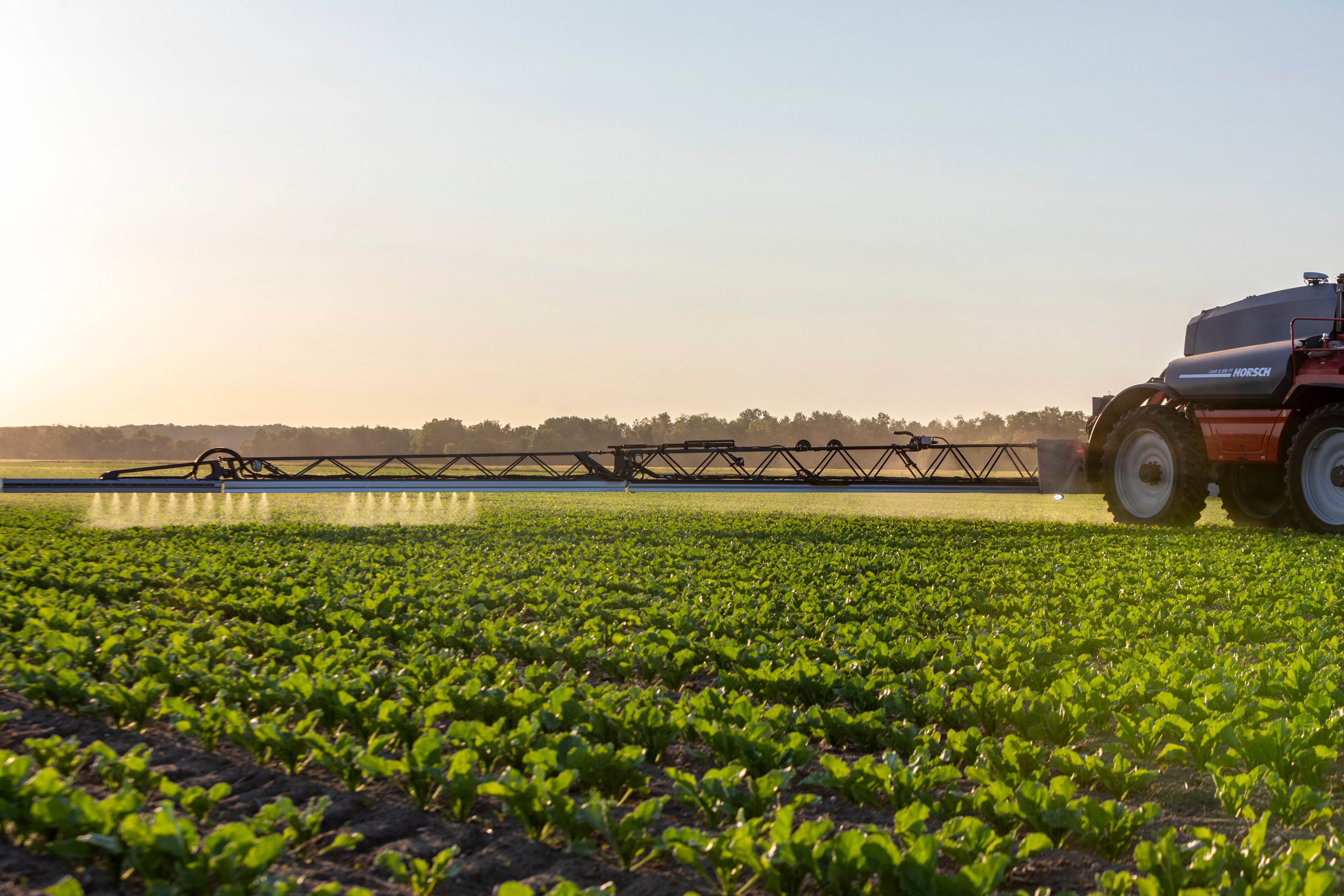HORSCH offers ‘spot spraying’ without an expensive camera system

“We’re seeing some confusion in the industry. HORSCH has been offering this system for the past two years, but it should be noted this is really ‘patch spraying’ as opposed to true ‘spot spraying’ which targets individual weeds. We are working hard on that too, but nobody can truly offer Green-on-Green spot spraying yet despite the term becoming more encompassing,” says Stephen Burcham, general manager at HORSCH UK.
“AutoSelect has been available to customers since we started selling sprayers, so the vast majority of our customers can take advantage of our proven selective spraying technology. Working with application maps, it offers a significant reduction in chemical use without incurring further prohibitive costs,” adds Mr Burcham.
Using drones to map the weed population ahead of spraying ensures the operator can mix the correct amount of chemical in the sprayer’s tank for the chosen application. This is a major advantage over real-time analysis for spot and patch spraying, which could leave significant levels of chemical in the sprayer at the end of the application.
Precision mapping with drones
HORSCH has been working with Agrovista as a supplier of drone mapping and precision services. Richard Dulake, precision services technical manager at Agrovista explains the process. “During the summer months, our Soil Sampling Team can turn their hands to drone operation. We have 10 sophisticated drones that can map our customers’ fields and create Green-on-Green data maps highlighting areas of weed growth.
“Some manual input is required in identifying the weed areas but once two or three areas have been highlighted, our AI software takes over and identifies all areas with either multiple or single plants. The spraying area is reduced to the smallest possible, but we usually use a minimum of 1m grids.”
Application maps instruct sprayers with nozzle and section control to apply chemical only where necessary. Two types of applications maps are available: point and radius, and polygon.
The more sophisticated ‘point and radius’ marks the centre of a weed population and draws a small circle to create a map of overlapping circular spray areas. “These maps supply far more data points, and the radius can be edited to allow for weed growth, for example, if there’s been a few days of rain since the field scan,” adds Mr Dulake.
The polygon data map creates a more rigid set of shapes that highlight weed growth areas. These have less data points but are more compatible with older control terminals.
HORSCH eosT10 terminal for point & radius data maps
Introduced at Agritechnica 2023, the HORSCH eosT10 and eosT10 Pro is a new generation of terminal focused on performance and an intuitive user experience. The high-resolution, touch-based 10-inch colour display terminal is ISOBUS-compliant to the ISO 11783 standard.
The high-performance hardware has comprehensive storage capacity and offers high speed even when processing large amounts of data. Application maps can be uploaded wirelessly and the ISOBUS SectionControl function can operate one boom and up to 120 sections, and is included in the standard version.
Customers with the eosT10 terminal can use the more data-intensive point and radius maps that allow a more targeted application of chemicals.
Patch and spot spraying
There is intensive focus on selective spraying to make plant protection even more efficient. True spot spraying means that the individual plant is assessed and treated allowing sprays to be used in an even more efficient and effective way.
The objective is to develop the new technology to meet the different environmental conditions and requirements of the farmers around the world. Green-on-Brown (GOB) plays a major role in dry regions, such as Australia, to remove individual weeds from the stubbles. Green-on-Green (GOG) is far more difficult to implement due to the small differentiation between weeds and emergent crops and is proving a challenge for experts across the agricultural industry. GOG is important in northern Europe, for example, for the application of herbicides or fungicides. Spot spraying GOG relies on sophisticated camera systems processing data in real time and is currently expensive and inconsistent.
Patch spraying brings much of the benefits at far lower price point that is easier to implement. AutoSelect enables a single boom section to be activated, just one or two metres rather than the entire boom, to ensure chemicals are only applied to that patch.
)
)
)
|https://cdn.asp.events/CLIENT_Haymarke_CB6BD562_5056_B731_4CF17C014C89B355/sites/cereals-2025/media/libraries/exhibitors/MF-logo-1-.jpg/fit-in/640x9999/filters:no_upscale())
|https://cdn.asp.events/CLIENT_Haymarke_CB6BD562_5056_B731_4CF17C014C89B355/sites/cereals-2025/media/libraries/exhibitors/EFM-1-.jpg/fit-in/640x9999/filters:no_upscale())
|https://cdn.asp.events/CLIENT_Haymarke_CB6BD562_5056_B731_4CF17C014C89B355/sites/cereals-2025/media/libraries/exhibitors/AF-logo-1-.jpg/fit-in/640x9999/filters:no_upscale())
|https://cdn.asp.events/CLIENT_Haymarke_CB6BD562_5056_B731_4CF17C014C89B355/sites/cereals-2025/media/libraries/exhibitors/farm-contractor-retina2.png/fit-in/640x9999/filters:no_upscale())
|https://cdn.asp.events/CLIENT_Haymarke_CB6BD562_5056_B731_4CF17C014C89B355/sites/cereals-2025/media/libraries/exhibitors/ISUZU UK LTD_logo.png/fit-in/640x9999/filters:no_upscale())
|https://cdn.asp.events/CLIENT_Haymarke_CB6BD562_5056_B731_4CF17C014C89B355/sites/cereals-2025/media/libraries/exhibitors/the-central-association-of-agricultural-valuers.png.png/fit-in/640x9999/filters:no_upscale())
|https://cdn.asp.events/CLIENT_Haymarke_CB6BD562_5056_B731_4CF17C014C89B355/sites/cereals-2025/media/libraries/exhibitors/e5fe77f9-2834-11ed-b1330a410bd8e1d9-logo.jpg/fit-in/640x9999/filters:no_upscale())
|https://cdn.asp.events/CLIENT_Haymarke_CB6BD562_5056_B731_4CF17C014C89B355/sites/cereals-2025/media/libraries/exhibitors/451f51e8-b7dc-11ef-b52-06bd0f937899-logo.jpg/fit-in/640x9999/filters:no_upscale())
|https://cdn.asp.events/CLIENT_Haymarke_CB6BD562_5056_B731_4CF17C014C89B355/sites/cereals-2025/media/libraries/exhibitors/sykes-holiday-cottages.jpg.jpg/fit-in/640x9999/filters:no_upscale())
|https://cdn.asp.events/CLIENT_Haymarke_CB6BD562_5056_B731_4CF17C014C89B355/sites/cereals-2025/media/libraries/exhibitors/uk-agritech-centre.png.png/fit-in/640x9999/filters:no_upscale())
|https://cdn.asp.events/CLIENT_Haymarke_CB6BD562_5056_B731_4CF17C014C89B355/sites/cereals-2025/media/libraries/exhibitors/Tees_POS_RGB.jpg/fit-in/640x9999/filters:no_upscale())
|https://cdn.asp.events/CLIENT_Haymarke_CB6BD562_5056_B731_4CF17C014C89B355/companyProfiles/19AFED0-8CFA-4C6B-A02F-EE49E7FE9A24-logo.jpg/fit-in/640x9999/filters:no_upscale())
|https://cdn.asp.events/CLIENT_Haymarke_CB6BD562_5056_B731_4CF17C014C89B355/sites/cereals-2025/media/libraries/exhibitors/PREMIUM CROPS_Logo.jpg/fit-in/640x9999/filters:no_upscale())
|https://cdn.asp.events/CLIENT_Haymarke_CB6BD562_5056_B731_4CF17C014C89B355/sites/cereals-2025/media/libraries/exhibitors/5f0c9802-b7dc-11ef-b52-06bd0f937899-logo.jpg/fit-in/640x9999/filters:no_upscale())
|https://cdn.asp.events/CLIENT_Haymarke_CB6BD562_5056_B731_4CF17C014C89B355/companyProfiles/FF5EBF7-26C6-4F39-9F42-C694FEBA2D7F-logo.png/fit-in/640x9999/filters:no_upscale())
|https://cdn.asp.events/CLIENT_Haymarke_CB6BD562_5056_B731_4CF17C014C89B355/sites/cereals-2025/media/libraries/exhibitors/NROSO_Logo.png/fit-in/640x9999/filters:no_upscale())
|https://cdn.asp.events/CLIENT_Haymarke_CB6BD562_5056_B731_4CF17C014C89B355/sites/cereals-2025/media/libraries/exhibitors/NITRASOL_logo.png/fit-in/640x9999/filters:no_upscale())
|https://cdn.asp.events/CLIENT_Haymarke_CB6BD562_5056_B731_4CF17C014C89B355/sites/cereals-2025/media/libraries/exhibitors/NIAB-CORRECT-LOGO.png/fit-in/640x9999/filters:no_upscale())
|https://cdn.asp.events/CLIENT_Haymarke_CB6BD562_5056_B731_4CF17C014C89B355/sites/cereals-2025/media/libraries/exhibitors/NAAC_Logo_final.jpg/fit-in/640x9999/filters:no_upscale())
|https://cdn.asp.events/CLIENT_Haymarke_CB6BD562_5056_B731_4CF17C014C89B355/sites/cereals-2025/media/libraries/exhibitors/KWS_Logo_RGB-2-.png/fit-in/640x9999/filters:no_upscale())
|https://cdn.asp.events/CLIENT_Haymarke_CB6BD562_5056_B731_4CF17C014C89B355/sites/cereals-2025/media/libraries/sponsors-list/Farmers-Weekly.png/fit-in/640x9999/filters:no_upscale())
|https://cdn.asp.events/CLIENT_Haymarke_CB6BD562_5056_B731_4CF17C014C89B355/sites/cereals-2025/media/libraries/exhibitors/9c88e4c0-7794-11ec-910-06e21988b83f-logo.jpg/fit-in/640x9999/filters:no_upscale())
|https://cdn.asp.events/CLIENT_Haymarke_CB6BD562_5056_B731_4CF17C014C89B355/sites/cereals-2025/media/libraries/exhibitors/CERES RURAL_logo.png/fit-in/640x9999/filters:no_upscale())
|https://cdn.asp.events/CLIENT_Haymarke_CB6BD562_5056_B731_4CF17C014C89B355/sites/cereals-2025/media/libraries/exhibitors/56aed295-bb58-11ec-910306e21988b83f-logo.png/fit-in/640x9999/filters:no_upscale())